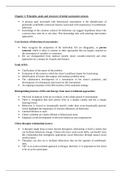Samenvatting
Summary Farmer, R.F. & Chapman (2016). Behavioral interventions in cognitive behavior therapy: Practical guidance for putting theory into action (second edition). Washington, DC, US: American Psychological Association.
- Instelling
- Rijksuniversiteit Groningen (RuG)
These notes are easy-to-read and include all the major concepts and summaries of this book. They will save you a lot of time since reading this book is time-consuming, especially when all your exams are during a small time frame. The writer of this document scored an 8.5 in this course.
[Meer zien]






